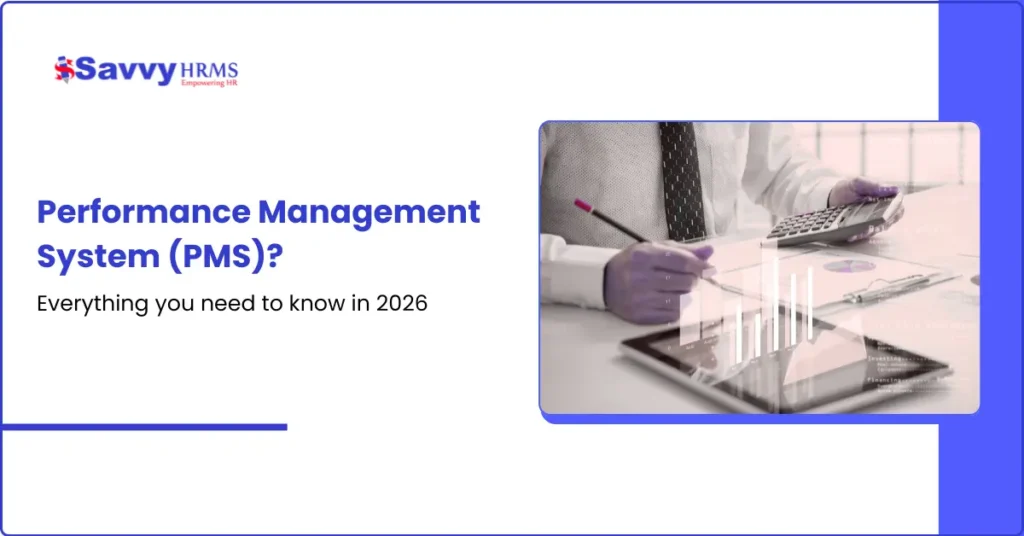Every company wants its employees to perform their best. But how do you know if your team is doing well? How do you help them grow? How do you keep the best people from leaving?
The answer is a performance management system (PMS).
A performance management system is like a roadmap for your company. It shows your employees where they need to go and helps them get there. It’s not just about finding who’s good and who’s bad at their job. It’s about helping everyone on your team become better at what they do.
In 2026, companies are using AI and new technology to make their performance management systems smarter. They’re moving away from old-fashioned yearly reviews and using continuous feedback instead. If you want your business to grow and keep your best employees happy, understanding PMS is essential.
This complete guide will explain everything you need to know about performance management systems in simple language. Whether you’re a business owner, HR manager, or team leader, this guide will help you understand PMS and how to use it effectively.
What is a Performance Management System (PMS)?
A performance management system is a structured process that helps organizations measure, track, and improve how well their employees perform at work. Think of it as a tool that connects what each employee does with what the company wants to achieve.
In simple words, a PMS helps you:
- Set clear goals for your employees so they know what to do
- Track their progress to see how they’re doing
- Give feedback to help them improve
- Reward good work to keep them motivated
- Identify areas where they need training or support
A good performance management system is not just a piece of software or a once-a-year review. It’s a continuous cycle that involves regular communication between managers and employees. It’s about building a culture where everyone understands their role and how they help the company succeed.
Why Do Organizations Need a Performance Management System?
Let me ask you a question: How do you know if your business is growing?
Usually, you look at money, customer satisfaction, and product quality. But what about your most important asset, your employees?
Here’s why organizations need a PMS:
1. Clear Direction and Focus
When employees don’t know what’s expected, they waste time on the wrong things. A PMS gives everyone a clear direction. It shows employees:
- What they need to do
- How their work helps the company
- What success looks like for their role
2. Better Employee Performance
Research shows that employees work harder when they:
- Know what’s expected of them
- Get regular feedback
- See how their work matters
- Are recognized for good work
A PMS does all of these things. This means better quality work and higher productivity.
3. Keep Your Best Employees
Companies lose talented people because they feel:
- Undervalued
- Stuck in their job with no growth
- Not recognized for their hard work
A good PMS makes employees feel important. It shows them a clear path to grow in their career. This helps you keep your best people.
4. Fair and Consistent Decisions
Without a PMS, promotion and pay decisions can seem unfair. Managers might make different choices based on personal feelings rather than actual performance. A PMS ensures:
- Fair treatment for everyone
- Decisions based on real data
- Transparency in how people are evaluated
5. Lower Costs
When you keep good employees and increase their productivity, you save money. You spend less on:
- Hiring new people
- Training new employees
- Fixing problems caused by unhappy staff
6. Reduce Legal Risk
If an employee loses their job, they might ask: “Why did this happen?” A PMS gives you documented proof of what was expected and how they performed. This protects your company legally.
How Does a Performance Management System Work?
Understanding how a PMS works is simple when you break it into steps. Think of it as a cycle that happens all year, not just once a year.
Stage 1: Planning (Goal Setting)
This is where it all starts. In this stage:
- Managers and employees meet together
- They discuss what the employee needs to do in the next period (3 months, 6 months, or 1 year)
- They create clear, measurable goals using SMART goals (Specific, Measurable, Achievable, Relevant, Time-bound)
Example: Instead of saying “Do better work,” you say “Increase sales by 10% in the next 3 months.“
Stage 2: Monitoring (Tracking Progress)
During this stage:
- Managers regularly check how employees are progressing
- They give feedback often, not just at the end of the year
- Employees can see their progress anytime
- Managers help solve problems early
In modern systems, this happens continuously. Employees get feedback weekly or monthly instead of waiting for a yearly review.
Stage 3: Development (Training and Support)
If an employee is struggling or wants to improve, the PMS helps:
- Identify what skills they need to learn
- Provide training or coaching
- Connect them with learning resources
- Create a plan for their career growth
Stage 4: Reviewing (Formal Evaluation)
At regular intervals, managers and employees have a formal meeting to:
- Discuss how well goals were achieved
- Review feedback from the entire period
- Discuss what went well and what could be better
- Plan for the next period
Stage 5: Rewarding (Recognition)
Good performance should be recognized. This stage includes:
- Giving bonuses or raises based on performance
- Promoting top performers
- Public recognition and praise
- Showing appreciation for hard work
What are the Key Components of a Performance Management System?
A good PMS has several important parts that work together. Let’s look at each one:
1. Goal Setting
Goals tell employees what success looks like. Good goals are:
- Specific – Clear and exact, not vague
- Measurable – You can count or measure them
- Achievable – Possible to reach with hard work
- Relevant – Connected to the company’s bigger goals
- Time-bound – Have a deadline
Example of a Good Goal: “Respond to all customer emails within 24 hours and achieve 95% customer satisfaction by June 30.”
2. Performance Reviews
Performance reviews are formal meetings where managers share feedback about how well an employee did their job. There are different types:
- Self-review – Employee reviews themselves
- Manager review – Manager reviews employee
- Peer review – Coworkers review each other
- 360-degree review – Everyone reviews (manager, peers, customers, subordinates)
3. Continuous Feedback
Instead of waiting for a yearly review, employees get feedback regularly. This can happen:
- In one-on-one meetings
- Through regular check-ins
- On specific projects
- In real-time when something happens
When feedback happens regularly, employees can fix problems quickly. They don’t have to wait months to know they’re on the wrong track.
4. Development Plans
These are personal learning plans for each employee. They include:
- Skills the employee needs to learn
- Training programs or courses
- On-the-job coaching
- Career growth opportunities
5. Rewards and Recognition
Employees work harder when they feel appreciated. This component includes:
- Bonuses based on performance
- Salary increases
- Promotions
- Public recognition
- Other benefits and perks
6. Data and Analytics
Modern PMS software collects data about:
- How well employees are doing
- Which goals are being achieved
- Trends in the company
- Which employees are top performers
Managers use this data to make smart decisions.
7. Communication and Documentation
Everything is documented in the system:
- Goals that were set
- Feedback that was given
- Reviews that were done
- Decisions that were made
This creates a clear record of everything.
Objectives of a Performance Management System
A PMS has clear objectives and goals that the company wants to reach by using it. Here are the main ones:
1. Align Individual Goals with Company Goals
Every employee should work towards the same big goals as the company. A PMS makes sure this happens by:
- Connecting individual goals to company goals
- Showing employees how their work matters
- Helping everyone focus on what’s most important
2. Measure and Evaluate Employee Performance
The system gives managers a fair way to:
- Measure how well each person is doing
- Compare performance across the team
- Identify top performers
- Find areas where people need help
3. Provide Fair and Consistent Feedback
A good PMS ensures:
- Everyone is evaluated the same way
- Feedback is based on facts, not feelings
- Employees know why they got certain feedback
- There’s less bias in the process
4. Identify Development Needs
The system helps find:
- What skills employees need to learn
- Where they struggle
- What training would help them succeed
- How to plan their career growth
5. Support Career Development
Employees want to grow in their careers. A PMS helps by:
- Showing clear career paths
- Identifying training opportunities
- Connecting employees with mentors
- Planning for future roles
6. Make Better HR Decisions
Managers use PMS data to make decisions about:
- Promotions and transfers
- Salaries and bonuses
- Layoffs and restructuring
- Succession planning (finding who will lead in the future)
7. Increase Employee Engagement and Retention
When employees feel valued and see growth opportunities, they:
- Stay with the company longer
- Work with more energy and enthusiasm
- Help recruit other good people
- Become brand ambassadors
What are the Benefits of a Performance Management System?
Using a good PMS brings real benefits to your company. Let’s look at the main ones:
1. Improved Employee Performance
Employees do better work when they:
- Know what’s expected
- Get regular feedback
- See clear goals
- Feel appreciated
Result: Your team becomes more productive and produces higher quality work.
2. Increased Employee Engagement
When employees see that the company cares about their growth and values their work, they become more engaged. They feel:
- Part of something important
- Valued and appreciated
- Motivated to do their best
Result: Happy employees who love their jobs and want to stay.
3. Better Communication
A PMS creates regular conversations between managers and employees. This leads to:
- Better understanding of expectations
- Quick problem-solving
- Stronger relationships
- More trust
Result: A better workplace culture where people talk openly.
4. Clear Career Paths
Employees can see how they can grow in the company. They understand:
- What skills they need to learn
- What jobs they can move into
- How to become a leader
- How to advance their career
Result: Employees stay longer and develop stronger loyalty.
5. Data-Driven Decisions
Instead of guessing, managers use real data to make decisions. They can see:
- Who the top performers are
- Which teams are doing best
- Where problems exist
- Which training works best
Result: Better decisions that help the company succeed.
6. Lower Turnover
When employees feel valued and see growth opportunities, they don’t leave. This saves your company:
- Money on hiring and training new people
- Time lost when people leave
- Knowledge that walks out the door
- The cost of being short-staffed
Result: A more stable, experienced team.
7. Better Customer Satisfaction
When your employees are happy and performing well, customers notice. Good employee performance leads to:
- Better customer service
- Fewer mistakes and problems
- Faster problem-solving
- Happier customers who come back
Result: More sales and better reputation.
8. Compliance and Legal Protection
A documented PMS protects your company by:
- Proving that decisions were fair
- Showing that feedback was given
- Creating a clear record of performance
- Defending against unfair termination claims
Result: Lower legal risk and better protection.
What Are the Types of Performance Management Systems?
Companies use different approaches to performance management. Let’s look at the main types:
Type 1: Management by Objectives (MBO)
What it is: Managers and employees work together to set clear objectives. Then the employee works to reach those objectives.
How it works:
- Set specific, measurable goals together
- Employee works independently to achieve them
- Manager checks progress regularly
- Review how well goals were met
- Plan for the next period
Best for: Companies where employees work somewhat independently and have clear measurable goals.
Example: Sales teams where you can measure success by “Close 5 new customers this month.”
Type 2: 360-Degree Feedback
What it is: Instead of just the manager reviewing the employee, feedback comes from everyone who works with them: manager, peers, subordinates, customers.
How it works:
- Employee gets feedback from multiple people
- Feedback covers different areas of performance
- Different perspectives show a complete picture
- Employee learns from many viewpoints
Best for: Companies that want a complete, fair view of each person’s performance.
Example: A team leader gets reviewed by:
- Their manager (how they lead)
- Their team (how they support them)
- Peers (how they work with others)
- Customers (how they serve them)
Type 3: Balanced Scorecard
What it is: Performance is measured in four areas: Finance, Customer, Internal Process, and Learning and Growth.
How it works:
- Company sets goals in all four areas
- Employee’s performance is measured against all four
- Ensures balanced, long-term success
- Not just about money
Best for: Large companies and strategic organizations wanting balanced growth.
Example: A company looks at:
- Finance: Revenue per employee
- Customer: Customer satisfaction
- Internal: Process efficiency
- Learning: Employee development
Type 4: OKR (Objectives and Key Results)
What it is: Clear objectives (big goals) with specific measurable results (key results) that show if the objective was achieved.
How it works:
- Set 3-5 important objectives for the period
- For each objective, define 3-4 key results (measurable outcomes)
- Track progress regularly
- Review and celebrate wins
Best for: Fast-growing companies and tech companies that want agility and focus.
Example:
- Objective: “Improve customer experience”
- Key Results: “Reduce response time to 2 hours, Increase satisfaction to 90%, Reduce complaints by 30%”
Type 5: Bell Curve Method
What it is: Employees are ranked from best to worst, usually placing about 20% at top, 70% in middle, 10% at bottom.
How it works:
- All employees are ranked
- Top performers get rewards
- Bottom performers get improvement plans
- Creates clear winners and losers
Note: This method is becoming less popular because it can:
- Create unfair competition
- Harm teamwork
- Make employees feel judged
- Not focus on growth
Type 6: Continuous Performance Management (CPM)
What it is: Regular, ongoing feedback and check-ins instead of formal yearly reviews.
How it works:
- Weekly or monthly one-on-one meetings
- Frequent feedback and coaching
- Real-time recognition and rewards
- Goals can be adjusted as needed
- No big surprise at yearly review
Best for: Modern companies that want to stay flexible and keep employees engaged.
Why it’s becoming popular: 80% of Gen Y (young workers) prefer regular feedback to yearly reviews.
Who Uses Performance Management Software?
Performance management systems aren’t just for HR departments. Many people use them:
1. Employees
- Set their own goals
- View their progress anytime
- Give themselves feedback
- Ask for development opportunities
- See how they’re doing
2. Managers/Team Leaders
- Set goals with their team
- Give regular feedback
- Track progress
- Make decisions about pay and promotions
- Identify who needs help
3. HR Professionals
- Design the PMS process
- Create forms and templates
- Ensure fairness and consistency
- Generate reports for the company
- Handle training and support
4. Company Leadership/Executives
- See company-wide performance data
- Make strategic decisions
- Understand trends
- Identify high potential people for leadership roles
5. Customers (in some systems)
- Give feedback on employees they work with
- Rate service quality
- Provide input on employee performance
Factors to Consider Before Buying a Performance Management System
Choosing the right PMS is important. Here are the key things to think about:
1. Your Company Size
Different systems work for different company sizes:
- Startups (1-50 people): Need simple, affordable systems
- Small companies (50-200): Need more features but not too complex
- Medium companies (200-1000): Need advanced features and integrations
- Large companies (1000+): Need complex systems that handle thousands of employees
2. Your Industry
Different industries have different needs:
- Tech companies often use OKR or continuous feedback
- Retail might use bell curve or MBO
- Manufacturing might use balanced scorecard
- Professional services often use 360-degree feedback
3. Budget
PMS software costs vary:
- Free or low-cost: $0-50 per employee per year
- Mid-range: $50-200 per employee per year
- Premium: $200+ per employee per year
Consider both software cost and implementation cost (setting it up).
4. Ease of Use
The best system is one that people will actually use:
- Is it easy to understand?
- Can your team use it without lots of training?
- Does it have a good app for mobile use?
- Is it intuitive and user-friendly?
5. Features You Need
Think about what’s most important for your company:
- Goal setting: Can you set SMART goals?
- Feedback: Can you give feedback easily?
- Reviews: Does it support 360-degree or other review types?
- Reporting: Can it show you the data you need?
- Integration: Does it connect with your other systems?
6. Customization Options
Every company is different:
- Can you customize forms and templates?
- Can you adjust the review process?
- Can you add your company values?
- Can you modify workflows?
7. Support and Training
When you have problems, you need help:
- Does the vendor provide good customer support?
- Is training available for your team?
- Do they have documentation and resources?
- Can they help with implementation?
8. Security and Data Privacy
Your employee data is sensitive:
- Is the system secure and encrypted?
- Does it follow data protection laws?
- Can you control who sees what information?
- Is the vendor reliable and established?
9. Integration with Other Systems
Your PMS should work with your other tools:
- Does it connect with your payroll system?
- Can it link to your HR information system (HRIS)?
- Does it work with your learning management system (LMS)?
10. Scalability
Think about the future:
- Can it grow with your company?
- Can it handle more employees later?
- Can it add new features as you need them?
- Is it built for the future?
Top 7 Performance Management Systems to Choose in India
If you’re looking for a good PMS for your company in India, here are seven popular options:
1. Savvy HRMS
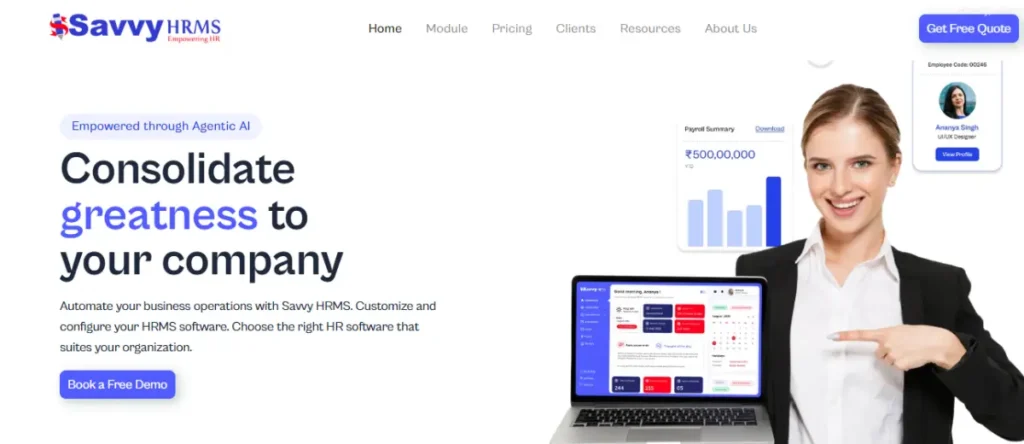
Savvy HRMS is a powerful Indian HRMS platform known for its strong and easy-to-use performance management system.
It is designed specifically for Indian companies, making it highly suitable for organisations that prefer local support and a tool that truly understands Indian HR processes. Savvy HRMS offers goal setting and tracking, 360-degree feedback, performance reviews, an employee self-service portal, and real-time analytics.
Savvy stands out for its simplicity, affordability, and ability to adapt to different business needs. Its customer service is highly appreciated, and its focus on automation helps companies reduce manual work and improve accuracy.
2. Darwinbox
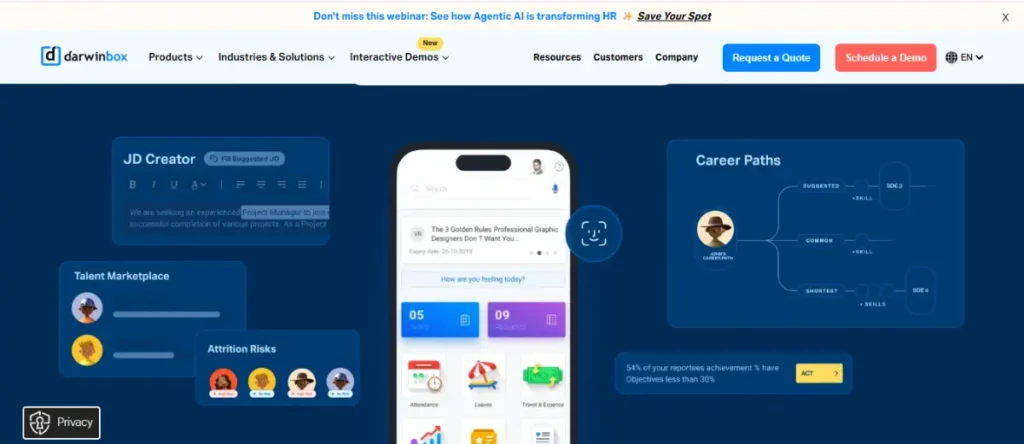
Darwinbox is a modern and advanced HR platform built for growing companies that need a complete HR solution. It includes OKR management, continuous feedback, performance ratings, learning and development tools, and employee recognition features.
Its clean interface, strong integrations, and AI-powered insights make it popular among mid-size and enterprise-level organizations looking for a futuristic HR system.
3. PeoplHum

PeoplHum is designed to improve employee engagement while offering strong performance management capabilities. It is best suited for companies that want a continuous feedback culture. With features like 360-degree feedback, performance reviews, real-time recognition, and engagement surveys, PeoplHum helps build a connected and motivated workforce.
Companies love it for its easy-to-use interface and focus on employee experience.
4. Leapsome
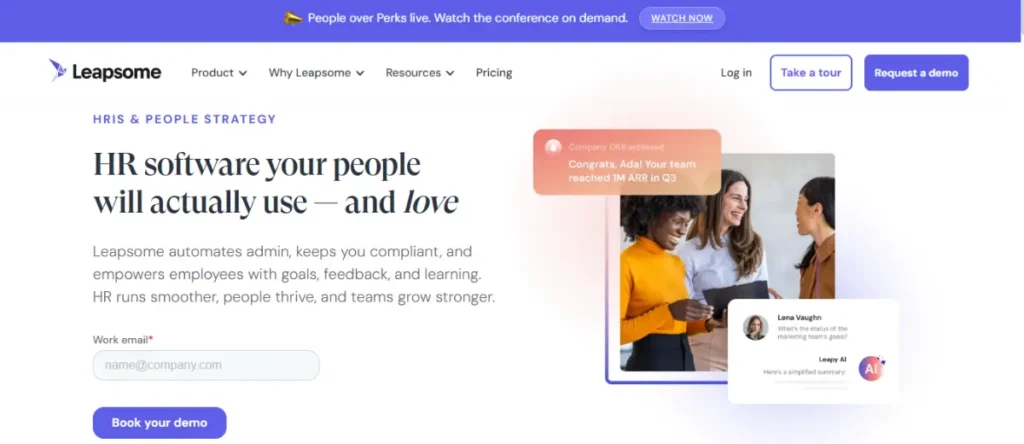
Leapsome is a comprehensive people management platform that combines performance, learning, and employee engagement in one place. It includes performance reviews, OKR and goal management, learning modules, 360-degree feedback, and competency frameworks.
Leapsome is known for its beautiful design, data-driven analytics, and all-in-one approach, making it ideal for organizations wanting a complete HR and performance solution.
5. Pocket HRMS
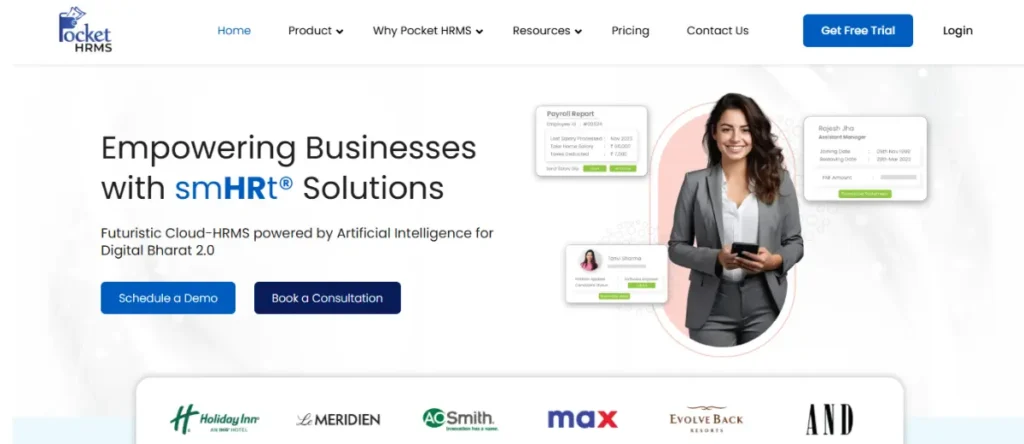
Pocket HRMS is an affordable HR software created for small and medium-sized businesses. It includes goal setting, performance reviews, 360-degree feedback, an ESS portal, and customizable workflows.
Its affordability, combined with a good feature set and local Indian support, makes it an excellent value-for-money choice for growing companies.
6. Engagedly

Engagedly focuses on modern and engagement-driven performance management. It offers continuous feedback, real-time and peer recognition, OKR management, and performance analytics. Its use of gamification makes performance management more interactive and motivating for employees.
This platform is a great option for companies that want to boost engagement while improving performance.
7. Zoho People
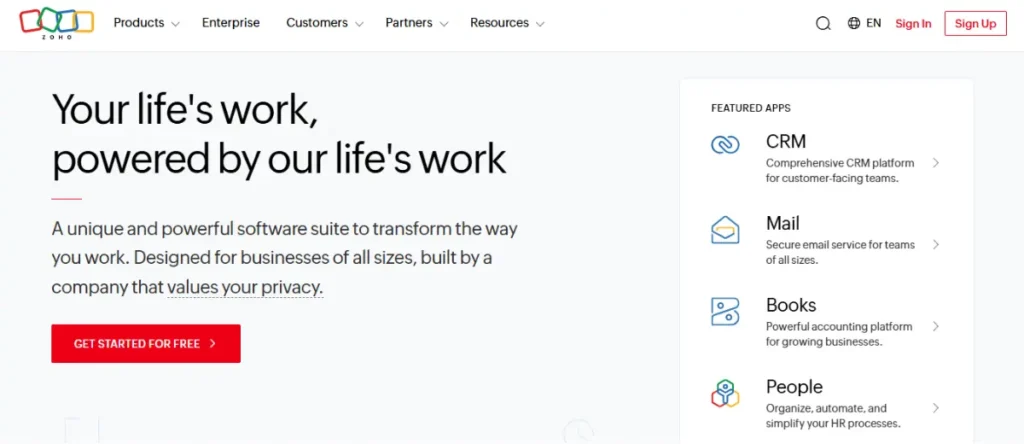
Zoho People is a popular HR software, especially for companies already using Zoho’s ecosystem. While performance management is one part of the platform, it includes performance appraisals, goal management, 360-degree feedback, custom workflows, and integration with other Zoho apps.
It is affordable, customizable, and highly suitable for small to medium businesses looking for a simple cloud HR solution.
Conclusion
A performance management system is one of the most important investments a company can make. It’s not just about reviewing how well employees work. It’s about creating a culture where:
- Everyone knows what’s expected
- People are valued and appreciated
- Growth and learning are encouraged
- The best people want to stay
- The company achieves its goals
In 2026, the best companies are moving away from old yearly reviews. They’re using continuous feedback, AI-powered insights, and flexible systems that adapt to their needs.
Whether you’re a small startup or a large company, whether you choose one of the systems we mentioned or find another one, remember this: The best PMS is the one your team will actually use.
Start with your company’s needs. Think about your budget and size. Choose a system that’s easy to use. Make sure your managers and employees are trained. Then, commit to using it consistently.
A performance management system is a structured process that helps organizations measure, track, and improve how well their employees perform at work. It connects what each employee does with what the company wants to achieve. A good PMS helps set clear goals, track progress, give feedback, reward good work, and identify areas where employees need training or support. It's not just a once-a-year review but a continuous cycle involving regular communication between managers and employees.
Organizations need a PMS for seven key reasons:
1) Clear direction and focus for employees
2) Better employee performance through feedback and recognition
3) Keeping best employees by showing growth opportunities
4) Fair and consistent decisions based on data
5) Lower costs through reduced turnover
6) Reduced legal risk with documented performance records
7) Improved employee engagement and retention through transparent processes.
key components of performance management system include:
1) Goal setting with SMART goals (Specific, Measurable, Achievable, Relevant, Time-bound)
2) Performance reviews (self-review, manager review, peer review, 360-degree)
3) Continuous feedback through regular check-ins
4) Development plans for skills and career growth
5) Rewards and recognition (bonuses, promotions, public recognition)
6) Data and analytics for smart decisions
7) Communication and documentation of all performance activities.
A PMS works in five stages:
1) Planning (goal setting) - managers and employees set clear goals
2) Monitoring (tracking progress) - managers give regular feedback and employees see progress
3) Development (training) - identify skills needed and provide support
4) Reviewing (formal evaluation) - discuss achievements and what went well
5) Rewarding (recognition) - give bonuses, promotions, or public recognition. This cycle repeats throughout the year, not just once annually.
Main objectives of Performance management system include:
1) Align individual goals with company goals
2) Measure and evaluate employee performance fairly
3) Provide consistent feedback based on facts
4) Identify development needs and training opportunities
5) Support career development and growth paths
6) Make better HR decisions about promotions and compensation
7) Increase employee engagement and retention.
Six main types of Performance management system include:
1) Management by Objectives (MBO) - set specific objectives and track achievement
2) 360-Degree Feedback - get feedback from manager, peers, subordinates, and customers
3) Balanced Scorecard - measure performance in Finance, Customer, Internal Process, and Learning areas
4) OKR (Objectives and Key Results) - clear objectives with measurable key results
5) Bell Curve Method - rank employees from best to worst (becoming less popular)
6) Continuous Performance Management (CPM) - regular feedback instead of yearly reviews (increasingly popular with 80% of Gen Y preferring it).
Eight key benefits of Performance management system include:
1) Improved employee performance through clear expectations and feedback
2) Increased employee engagement and motivation
3) Better communication and understanding between managers and employees
4) Clear career paths showing growth opportunities
5) Data-driven decisions instead of guessing
6) Lower employee turnover and retention of top talent
7) Better customer satisfaction through improved employee performance
8) Compliance and legal protection through documented performance records.
Continuous Performance Management (CPM) replaces yearly reviews with regular, ongoing feedback and check-ins. It includes weekly or monthly one-on-one meetings, frequent feedback and coaching, real-time recognition and rewards, and adjustable goals as needed. Employees never get surprised at yearly reviews. CPM is becoming increasingly popular because 80% of Gen Y prefers regular feedback to yearly reviews, making it ideal for modern, engaged workforces.

